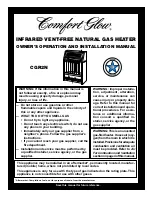
9
WARNING
SOOT BUILD-UP INDICATES A PROBLEM THAT REQUIRES
CORRECTION BEFORE FURTHER USE. CONSULT WITH A
QUALIFIED SERVICE TECHNICIAN.
Should the main burner or burner air openings require cleaning,
turn the gas control knob to “OFF” position and allow the burner to
cool. Remove the burner and clean with a soft brush. Clean main
burner orifice with a suitable soft material.
HIGH TEMPERATURE LIMIT SWITCH
(Single-Use Type Energy Cut Off)
The thermostat has a built-in limit switch which will extinguish the
pilot light in case of excessive water temperatures. The pilot cannot
be relit until the entire thermostat (labeled as single-use type) is
replaced. It is important that a serviceman be called to determine
the reason for limit operation and thus avoid repeated thermostat
replacement. Lower the temperature adjustment dial setting on new
control.
VENTING SYSTEM
HAVE VENTING SYSTEM CHECKED EVERY TWELVE MONTHS
FOR OBSTRUCTIONS AND/OR DETERIORATION IN VENT PIP-
ING.
T & P VALVE
At least once a year, the temperature and pressure relief valve must
be checked to ensure that it is in operating condition. Lift the lever
at the top of the valve several times until the valve seats properly
and operates freely.
WARNING
THE WATER PASSING OUT OF THE VALVE DURING THIS
CHECKING OPERATION MAY BE EXTREMELY HOT. AVOID
CONTACT AND DISCHARGE SAFELY TO PREVENT WATER
DAMAGE.
DRAINING
If the heater is to be shut off and exposed to freezing temperatures,
it must be drained. Water, if left in the tank and allowed to freeze,
will damage the heater.
• Turn off the gas and cold water inlet valve to the heater.
• Open a nearby hot water faucet and the heater drain valve
BE CAREFUL TO GRASP THE DRAIN VALVE HANDLE SO THAT
THE HAND IS NOT EXPOSED TO HOT WATER. IF DESIRED, A
HOSE MAY BE CONNECTED TO THE DRAIN VALVE TO CARRY
THE WATER AWAY.
DANGER: The water CAN BE HOT.
• The drain valve must be left open during the shutdown period.
• To restart heater, refer to the FILLING instructions under
OPERATION.
Periodically open the drain valve and allow the water to run until it
flows clean. This will help prevent sediment build-up in the tank.It
is normal for lime and scale deposits to form within the tank. Such
deposits will not be removed by periodic draining. It is necessary to
chemically delime the affected parts in water areas where such
deposits are encountered. Contact your dealer or plumber for
deliming information.
CONDENSATION
Water vapor can condense on the cooler surfaces of the tank form-
ing droplets, these drip into the fire or run out on the floor. This is
common at the time of startup after installation, during periods of
time when incoming water is very cold, or the heater may be under-
sized for the requirements.
If water drops fall from the draft hood, it is water vapor condensed
from combustion products due to a problem in the vent. It may also
be the result of leaking rain water.
Droplets from the bottom of the flue may be due to corrosive com-
bustion products or improper vent. Check with your dealer for more
information.
CATHODIC PROTECTION-ANODE
The anode rod with the tank is designed to be slowly consumed
cathodically, minimizing corrosion in the glass lined tank. A hydrogen
sulfide (rotten egg odor) may result if water contains high sulfate
and/or minerals. Chlorinating the water supply should minimize the
problem. (See EXTENDED NON-USE PERIODS).
NOTE: Anode must remain installed (except for inspection) to avoid
shortening tank life. See LIMITED WARRANTY. Replace as
necessary.
ANODE ROD MAINTENANCE
The anode rod is used to protect the tank from corrosion. Most hot
water tanks are equipped with an anode rod. The submerged rod
sacrifices itself to protect the tank. Instead of corroding the tank,
water ions attack and eat away the anode rod. This does not affect
the water's taste or color. The rod must be maintained to keep the
tank in operating condition. Failure to inspect and/or replace the
anode rod will result in voiding the warranty.
Anode deterioration depends on water conductivity, not necessarily
water condition. It may be necessary to have the anode rod in-
spected a few times during the first year to see what effect the water
has had. A corroded or pitted anode rod, in the first year, indicates
high water conductivity and should be checked and or replaced more
often than an anode rod that appears to be fairly clean. Inspection
should be conducted by a qualified technician.





























